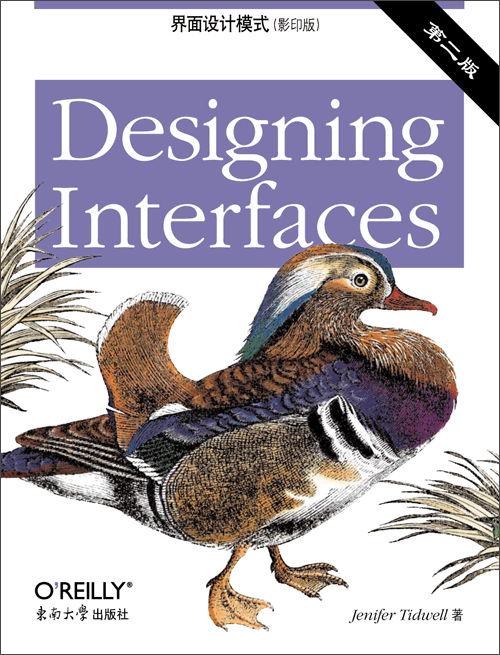界面设计模式(第二版,影印版)
出版时间:2011年06月
页数:549
尽管目前已经存在了各种各样的用户界面设计工具,设计良好的应用界面仍然不是一件容易的事情。这本畅销书是极少数可以信赖的资料,它能帮助你走出设计选项的迷宫。通过把捕捉到的最佳实践和重用思想体现为设计模式,《界面设计模式》提供了针对常见设计问题的解决方案,这些方案可以被裁减以适用于你的具体情况。
本修订版包括了手机应用和社交媒体的模式,以及Web应用和桌面软件。每个模式包含了用全彩方式展现的运用技巧,以及你可以立刻取用的务实建议。有经验的设计人员可以把这本指南作为思想的源泉,而新手则可以通过它发现一条通往界面和交互设计世界的大道。
· 以更自信和更少猜测设计吸引人的易用界面
· 学会经常被错误理解的设计概念,比如受应性、视觉层次、导航距离和色彩的运用
· 获得针对特殊用户界面的建议,包括替代方案和什么时候不应该使用它
· 在觉得恰当的时候混和与重新组合用户界面设计的想法
· 基于图形化设计原则和模式美化用户界面的外观
“任何一个对界面设计感兴趣的人都应该把这本书放到书架上作为参考。这是目前最全面的常见界面设计模式的跨平台评测。”
——Dan Saffer
《Designing Gestural Interfaces》(O’Reilly出版)和
《Designing for Interaction》
(New Riders出版)的作者
Jenifer Tidwell是交互界面设计、信息架构和预设计分析方面的作家和顾问。她为很多公司,比如Goole和MathWorks,设计和搭建过用户界面。
本修订版包括了手机应用和社交媒体的模式,以及Web应用和桌面软件。每个模式包含了用全彩方式展现的运用技巧,以及你可以立刻取用的务实建议。有经验的设计人员可以把这本指南作为思想的源泉,而新手则可以通过它发现一条通往界面和交互设计世界的大道。
· 以更自信和更少猜测设计吸引人的易用界面
· 学会经常被错误理解的设计概念,比如受应性、视觉层次、导航距离和色彩的运用
· 获得针对特殊用户界面的建议,包括替代方案和什么时候不应该使用它
· 在觉得恰当的时候混和与重新组合用户界面设计的想法
· 基于图形化设计原则和模式美化用户界面的外观
“任何一个对界面设计感兴趣的人都应该把这本书放到书架上作为参考。这是目前最全面的常见界面设计模式的跨平台评测。”
——Dan Saffer
《Designing Gestural Interfaces》(O’Reilly出版)和
《Designing for Interaction》
(New Riders出版)的作者
Jenifer Tidwell是交互界面设计、信息架构和预设计分析方面的作家和顾问。她为很多公司,比如Goole和MathWorks,设计和搭建过用户界面。
- Introduction to the Second Edition
- Preface
- 1. What Users Do
- A Means to an End
- The Basics of User Research
- Users’ Motivation to Learn
- The Patterns
- Safe Exploration
- Instant Gratification
- Satisficing
- Changes in Midstream
- Deferred Choices
- Incremental Construction
- Habituation
- Microbreaks
- Spatial Memory
- Prospective Memory
- Streamlined Repetition
- Keyboard Only
- Other People’s Advice
- Personal Recommendations
- 2. Organizing the Content:
- Information Architecture and Application Structure
- The Big Picture
- The Patterns
- Feature, Search, and Browse
- News Stream
- Picture Manager
- Dashboard
- Canvas Plus Palette
- Wizard
- Settings Editor
- Alternative Views
- Many Workspaces
- Multi-Level Help
- 3. Getting Around: Navigation, Signposts, and Wayfinding
- Staying Found
- The Cost of Navigation
- Navigational Models
- Design Conventions for Websites
- The Patterns
- Clear Entry Points
- Menu Page
- Pyramid
- Modal Panel
- Deep-linked State
- Escape Hatch
- Fat Menus
- Sitemap Footer
- Sign-in Tools
- Sequence Map
- Breadcrumbs
- Annotated Scrollbar
- Animated Transition
- 4. Organizing the Page: Layout of Page Elements
- The Basics of Page Layout
- The Patterns
- Visual Framework
- Center Stage
- Grid of Equals
- Titled Sections
- Module Tabs
- Accordion
- Collapsible Panels
- Movable Panels
- Right/Left Alignment
- Diagonal Balance
- Responsive Disclosure
- Responsive Enabling
- Liquid Layout
- 5. Lists of Things
- Use Cases for Lists
- Back to Information Architecture
- Some Solutions
- The Patterns
- Two-Panel Selector
- One-Window Drilldown
- List Inlay
- Thumbnail Grid
- Carousel
- Row Striping
- Pagination
- Jump to Item
- Alphabet Scroller
- Cascading Lists
- Tree Table
- New-Item Row
- 6. Doing Things: Actions and Commands
- Pushing the Boundaries
- The Patterns
- Button Groups
- Hover Tools
- Action Panel
- Prominent “Done” Button
- Smart Menu Items
- Preview
- Progress Indicator
- Cancelability
- Multi-Level Undo
- Command History
- Macros
- 7. Showing Complex Data:
- Trees, Charts, and Other Information Graphics
- The Basics of Information Graphics
- The Patterns
- Overview Plus Detail
- Datatips
- Data Spotlight
- Dynamic Queries
- Data Brushing
- Local Zooming
- Sortable Table
- Radial Table
- Multi-Y Graph
- Small Multiples
- Treemap
- 8. Getting Input from Users: Forms and Controls
- The Basics of Form Design
- Control Choice
- The Patterns
- Forgiving Format
- Structured Format
- Fill-in-the-Blanks
- Input Hints
- Input Prompt
- Password Strength Meter
- Autocompletion
- Dropdown Chooser
- List Builder
- Good Defaults
- Same-Page Error Messages
- 9. Using Social Media
- What This Chapter Does Not Cover
- The Basics of Social Media
- The Patterns
- Editorial Mix
- Personal Voices
- Repost and Comment
- Conversation Starters
- Inverted Nano-pyramid
- Timing Strategy
- Specialized Streams
- Social Links
- Sharing Widget
- News Box
- Content Leaderboard
- Recent Chatter
- 10. Going Mobile
- The Challenges of Mobile Design
- The Patterns
- Vertical Stack
- Filmstrip
- Touch Tools
- Bottom Navigation
- Thumbnail-and-Text List
- Infinite List
- Generous Borders
- Text Clear Button
- Loading Indicators
- Richly Connected Apps
- Streamlined Branding
- 11. Making It Look Good: Visual Style and Aesthetics
- Same Content, Different Styles
- The Basics of Visual Design
- What This Means for Desktop Applications
- The Patterns
- Deep Background
- Few Hues, Many Values
- Corner Treatments
- Borders That Echo Fonts
- Hairlines
- Contrasting Font Weights
- Skins and Themes
- References
- Index
书名:界面设计模式(第二版,影印版)
作者:Jenifer Tidwell 著
国内出版社:东南大学出版社
出版时间:2011年06月
页数:549
书号:978-7-5641-2684-1
原版书书名:Designing Interfaces, Second Edition
原版书出版商:O'Reilly Media
These birds live in woodland areas near streams and lakes. Being omnivorous, they tend
to have a seasonal diet, eating acorns and grains in autumn; insects, land snails, and
aquatic plants in spring; and dew worms, grasshoppers, frogs, fish, and mollusks during
the summer months.
The mating ritual of Mandarin ducks begins with an elaborate and complex courtship
dance that involves shaking movements, mimed drinking gestures, and preening. Males
fight each other to win a female, but it is ultimately the female who decides her mate.
Mandarin ducklings instinctively follow their notoriously protective mothers, who will
feign injury to distract predators such as otters, raccoon dogs, mink, polecats, eagle owls,
and grass snakes.
Mandarin ducks are not an endangered species, but they are considered to be threatened.
Loggers continuously encroach upon their habitats, and hunters and poachers prize the
males for their plumage. Their meat is considered unpalatable by humans, and they are
generally not hunted for food.
to have a seasonal diet, eating acorns and grains in autumn; insects, land snails, and
aquatic plants in spring; and dew worms, grasshoppers, frogs, fish, and mollusks during
the summer months.
The mating ritual of Mandarin ducks begins with an elaborate and complex courtship
dance that involves shaking movements, mimed drinking gestures, and preening. Males
fight each other to win a female, but it is ultimately the female who decides her mate.
Mandarin ducklings instinctively follow their notoriously protective mothers, who will
feign injury to distract predators such as otters, raccoon dogs, mink, polecats, eagle owls,
and grass snakes.
Mandarin ducks are not an endangered species, but they are considered to be threatened.
Loggers continuously encroach upon their habitats, and hunters and poachers prize the
males for their plumage. Their meat is considered unpalatable by humans, and they are
generally not hunted for food.
购买选项
